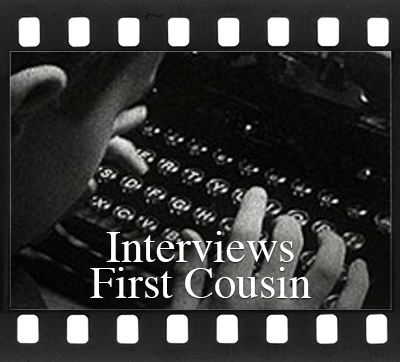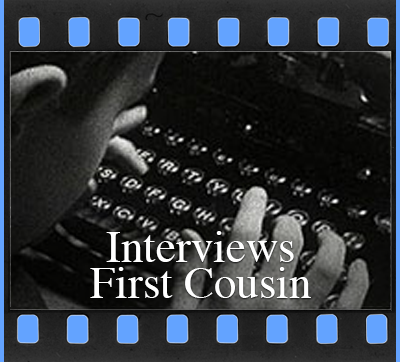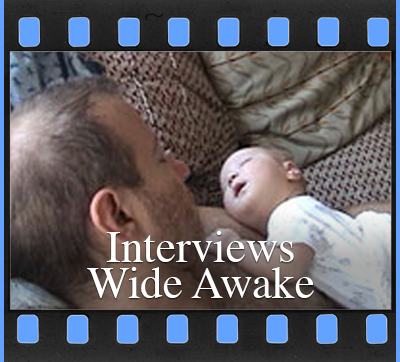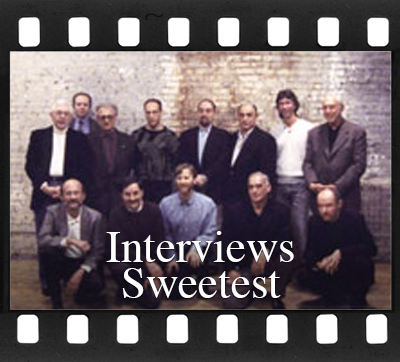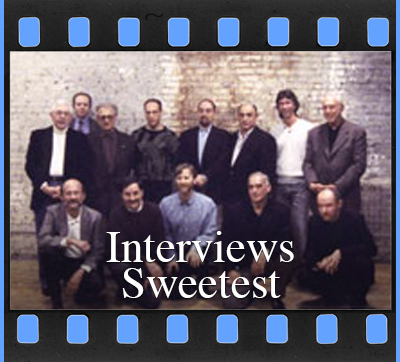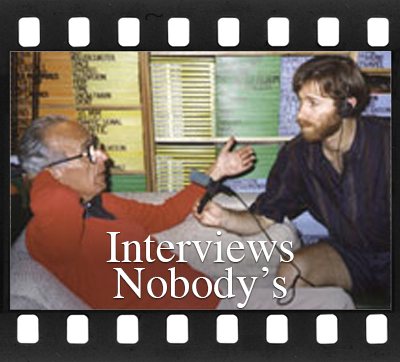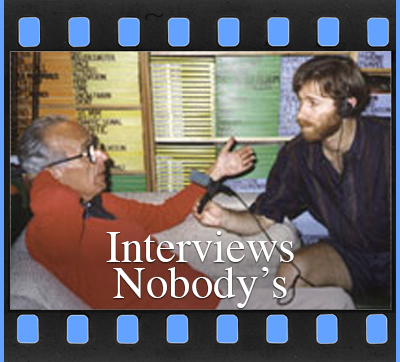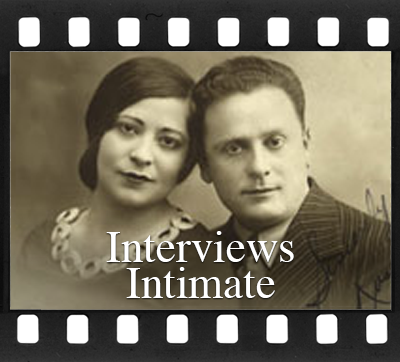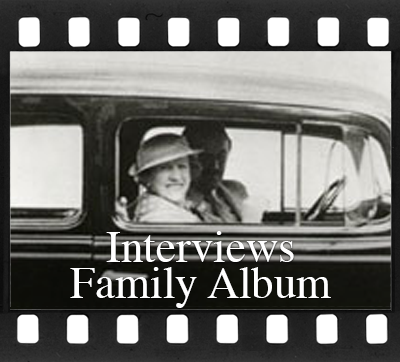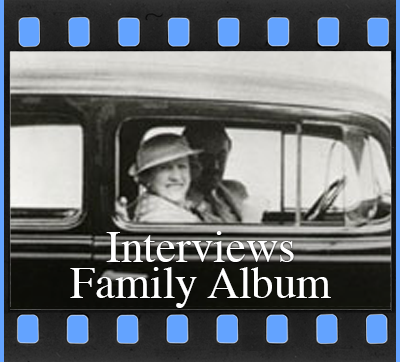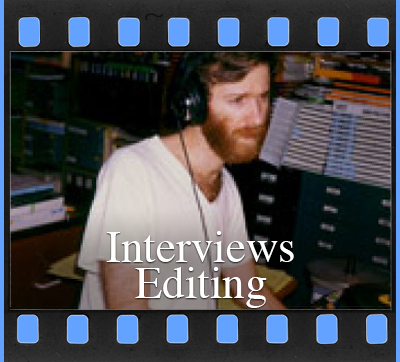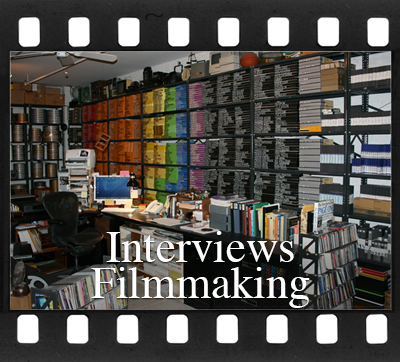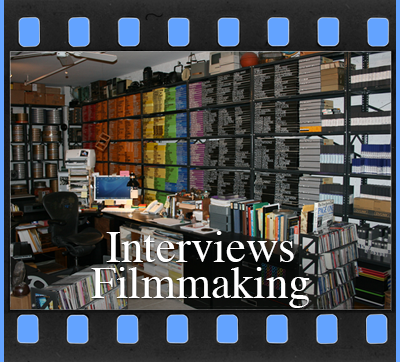Editing
Interviews
ALAN BERLINER ON EDITING
An Interview with Gabriella Oldham
August 24 1990
July 2, 1986, 3:11 a.m. - I lived the process of making the film—I was that process.... It didn’t matter where I was or what I was doing.
Editors hired to cut other filmmakers’ visions admit to living with the film, daily and obsessively, as if it were their own. For an editor who is also a filmmaker, the obsession is both inexpressible and perfectly articulate. Alan’s life is inseparable from his films and vice versa. These random excerpts from his personal journals reflect the midnight thoughts of a filmmaker-editor who spends sleepless hours deliberating over “four words too many” or “two frames too long” to create his life-works.
May 3, 1985, 2:10 a.m. - Each day I will attempt to get a little bit closer—will absorb a little bit more.... Imagine a bird building its nest twigdust by twigdust.
Alan creates poetic metaphors to define the mystery of editing. Because it is so entwined with his life, one almost forgets that Alan is speaking primarily of editing. He likens “the process” to chemistry, nutrition, friendship, stamp collecting, evolution, surgery (June 23, 1986, 3:56 a.m. - I opened the patient. I touched the film.) and, especially, mountain climbing. His studio is breathtaking: part museum, part archive. His enormous collections of sounds, images, photographs, and objects are catalogued in spectral-colored boxes, spanning one wall like a rainbow; rows of cabinets hold his notebooks and personal journals; shelves upon shelves are filled with organized files of newspaper clippings, correspondence, and photographs cross-referenced to the awe and envy of any librarian. Space is filled to capacity with projects past, present, and future: sculpture made from old discarded film reels, tens of thousands of photographs clipped from The New York Times, boxes and boxes of old American home movies from the 1920s and 1930s. Alan believes that before long, everything ultimately finds a purpose and a place in his work; that with acute “noticing,” the potentials for film become endless.
May 4, 1985, 2:30 a.m. - Just tonight I have 5 or 6 scratch pads screaming out with barely legible inklings of thought, of possibility.
Of noticings.
Editing is the consequence of noticing.
Everything gets written down so that nothing, no spark of thought, no matter how trivial or ephemeral escapes future consideration/fermentation.
Alan hopes that his current project, Intimate Stranger, will be both a portrait of his grandfather and a poetic document of his own personal quest to cinematically unravel and portray the story. He worries, though, that in finding his family roots, he risks chopping down the tree. Despite the film’s personal focus, Alan hopes to discover how Intimate Stranger will reveal its universal core, and tap into themes of human vulnerability as did The Family Album. Alan regards the process as not unlike walking down darkened streets; he is compelled to explore every turn of the unknown and mysterious geography. To see a subject, to make a film, Alan embraces life’s many often ironic juxtapositions and translates them tenderly into his films. The journey to find himself in the process of making his films is exhilarating and remains never-ending.
August 17, 1989, 2:59 a.m. - I am actually meeting this man, finally—so long after his death, digesting his ups, his downs, his sense of mission, his gifts, and of course, his tragic flaws.... Overwhelmed by the fabrics of connection, actual and unspoken; threads of affinity and rejection; the confusing crossroads of cultural difference, familial pattern, and genetic fact.
CREDITS
| 1975 | Patent Pending (12 minutes) |
| 1976-77 | Four Corner Time (40 minutes) |
| 1977 | Color Wheel (25 minutes) |
| 1979 | Lines of Force (7 minutes) |
| 1980 | City Edition (10 minutes) |
| 1981 | Myth in the Electric Age (15 minutes) |
| 1983 | Natural History (13 minutes) |
| 1985 | Everywhere at Once (10 minutes) |
| 1986 | The Family Album (60 minutes) |
| 1989 | Broadway Dreamers (The Legacy of the Group Theater) |
| 1991 | Intimate Stranger |
How did your educational background help you develop film as an experimental form of personal expression?
I was fortunate to have attended a program that taught film as an art form. At most universities, film is taught primarily as part of other disciplines—theater, literature, communications, broadcasting, among others. I have a B.A. in Cinema, or so-called avant-garde personal filmmaking from the State University of New York at Binghamton. It’s one of the few places in the country where you can study film not as a satellite of any other discipline, or as a tool of media, but as a unique art form unto itself—crucial, vibrant, and dynamic in the history of twentieth century culture and society. From there, I received an M.F.A. degree in Film/Video from the School of Art at the University of Oklahoma, home of another experimental filmmaking program throughout the 1970s. I lived in Oklahoma for two years, taught film production courses there, got my Master’s degree, and then returned to New York City. At that time, I was passionately committed to continuing my personal filmmaking, but I was also, of course, charged with the responsibility of putting a roof over my head and supporting myself. By the way, in film/art school, we were taught to do everything: we filmed, we edited, we negative-matched—the entire process. The conventional world of film school production divides filmmaking by craft or function: are you a producer, a director, an editor, a cinematographer? What specialization do you choose? Upon returning to New York in 1979 and seeking professional employment, it was difficult for me to have to choose a job in any one of these areas because I loved the entire process so much. It seemed both an unnatural and limiting situation to be in. It just so happened that the few connections I did have with the New York film industry were in editing, so I got my first job as an assistant editor. It was a strange new environment, far, far away from the world of art schools and experimental film. I should tell you that although I had a B.A. and an M.F.A. in film, both with highest honors, I didn’t know a thing about how a professional cutting room, how a conventional editing room was set up, let alone operated. I didn’t even know what I didn’t know. What I did know was that the most important thing was for me to maintain my relationship with my own personal film work—to keep working on my own films. I kept making distinctions. Working for them was my job, creating my own films was my work. My entree into the film industry literally changed the course of my work and my life. I was to be around Steenbecks and many other editing tools all the time, and I realized that if I didn’t abuse the privilege, I could work for them by day and stay after hours and work on my own projects at night. When their day was over, my night began.
It must have seemed like two separate worlds to you. What was your first job in the “outside” world?
The very first job I got was working for ABC Sports, specifically a program called The American Sportsman. Ted Winterburn, the supervising editor there, in effect made a position for me. He said, “You’ll be paid as an assistant editor, but your role for now will be to organize our sound effects library.” So for approximately nine months, I was a sound effects librarian; I’d come to work and listen to sounds all day. I was allowed to create my own work environment of atmospheric low light in contrast to most of the other editing rooms which were primarily fluorescent, the light of industry. I felt comfortable and exhilarated. It was actually quite an unusual job. I’d come home and someone would ask, “What did you do today?” I’d tell them that I’d listened to waterfalls all day, or exotic Arctic winds, or thirty-three variations of fire.
Did you choose what to listen to?
Sort of. A virtual mountain of miscellaneous sound effects had to be listened to, annotated, and catalogued. Some days I would listen to the sounds of footsteps on gravel or on wood or on metal or on grass or on dirt—on every possible surface. Other days for a change of pace, I would listen to monkeys or elephants or whales or crickets. The American Sportsman had an incredible library of sounds, mostly recorded in the field from all over the world, primarily from nature and nature-related sports endeavors. At the end of nine months, I had created an auxiliary library to augment their pre-existing one. I remember finally producing a very thick notebook, the “3000 series” (their standard library started at 0000) of sound effects.
Why did you create an “atmosphere” for listening in the room?
I think when you’re working in your own editing room, the ambiance that you create is an important part of the process. I’m a big believer that process and product are directly related; that many intrinsic things often taken for granted can contribute to the process in some very subtle but significant ways. The wonderful thing about that job was that I was virtually on my own, without any pressure, and I had the time and the freedom to observe the ways and procedures of this new industrial environment. I was learning the language and the lingo. I would observe others at work and continually ask questions, “What are you doing?” “Why are you doing it that way?” I was absorbing. For nine months, I had this secret tutelage, this self-education in the ways of the industry. As a result, I was somewhat prepared when Ted eventually said to me, “We now need you to be an assistant sound editor”—the organization of the sound library was finally completed and things were starting to get very busy. I did that for one year and then the following year I was made a sound editor. I suppose I was extremely valuable to them because I knew what and where all the sound effects were! Virtually every editor would come to me seeking help in solving unusual sound effects problems.
Was this the first time you had worked so intensely in sound?
Yes. It was quite new. I think that’s why I grabbed onto sound so easily and so quickly, because it was all so new to me and I was hungry to learn. If you learn something with a certain amount of passion and excitement, you’ll tend to be good at it. It’s a question of where you are in your own personal history, in your own continuum of life experience that determines how you relate to, or use, new information. I was especially excited then because I was making a transition from being a student to earning a living. Ironically, I was actually being paid to learn. On one occasion during the course of my work on the sound effects library, I took a role of red tape, make a large grid on the rewind table, and sorted out many small rolls of 16mm mag track by category. A few people walking by were somewhat mystified by what I was doing. They wanted to know if this was a procedure that they didn’t know about. I said, “No, it’s nothing, it just helps me organize such a large quantity of material.” I remember being amused and intrigued because apparently they were curious about what I was doing as well. But always in the back of my mind was, “This is a great place to work because I can use the Steenbecks at night.” I knew that I was learning and discovering things that I would be able to utilize in my own film work down the road.
Do editors usually develop personal organizational devices like that?
Editing is about organization and order. I think we’ll uncover several definitions about what editing is, and all of them are as false as they are true because, ultimately, editing is about the thought process itself. There are as many different thought processes out there as there are people to think them. However you might define what editing is, there will always be someone who has a genius, a unique approach, to circumvent or defy whatever definition you might try to place on it; someone who would come upon it from an entirely different set of pathways and do equally intriguing, interesting, and exciting work. It’s not really that hard to be organized, but most organized people will tell you that chaos or disorder is an important part of their process. Some people are chaotic at home or in their personal lifestyle, and use the editing room as a haven for order. There’s a balance, a dialectic going on in their lives. My own sense of organization is all a part of a process I live and breathe both inside and outside the editing room. It’s organic to me—not motivated from some objective standpoint exclusively. I don’t consciously try to be organized and only over the past several years have I realized how intuitive it all really is. I need to be organized primarily because I utilize massive volumes of information and material in most of my projects. I choose to surround myself and work with voluminous and complex elements. It’s a question of knowing where things are in order to be able to use them. The organization of my studio is totally idiosyncratic. I have my own buzzwords, codifications, my own shorthand for things. But, at the same time, if I were not present to explain it, I believe my individual sense of order would make sense, would be translatable, to anyone interested in exploring it.
In organizing the material, you are also creating atmosphere. People might use black and white boxes to store film, but you use rainbow colors.
Spectral colors. I like the way they look and feel. I need my film and art-making process to have a certain elegance, both inside and outside. I want the things I make to reflect the care and thought of the process that went into making them. Everything I do, every thing I do, is tied into the atmosphere of my studio. Ultimately, it’s an extension of me. As I mentioned, anyone interested in systems of organization also knows the place and role of its opposite: the geography of anarchy, entropy, and chaos—the process of getting lost. There are times when I let this place become cluttered and disheveled, because I know that in cleaning it up I can reappraise my entire personal system, my own sense of myself, and can refine and redefine myself at a new, maybe higher, level. I don’t know how many times simply moving a piece of furniture or changing the face of my bookshelves has literally uplifted me and renewed me. It takes on a profound psychological dimension.
When you work, do you create a mess around you?
Absolutely. Editing is messy. It’s about getting your hands dirty.
Are your thoughts as messy?
Sure. You have to get lost in order to find your way. Thought by its very nature is messy. I don’t think there’s anyone who gets it exactly right the first time, who finds the road toward his or her own personal sense of perfection in a straight line. There’s always a garbage pile of discarded concepts, a map of discarded paths and trails along the way. Good editors need to be able to throw things away. Yesterday’s great ideas may well be tomorrow’s trash. It’s the ability to let go. Thought is not precious, thought is like clay. Sometimes it requires a finger pushing in from the right bottom and another three fingers pushing in on the left. Sometimes you need to put the piece of clay back in your hands and start all over again. You have to be able to let go. That’s because editing is a responsive endeavor. You look at this pile of clay, this malleable stuff, and you make choices. Everyday your vantage point changes as does your relationship to what was there initially and what your aspirations for it had been. You have to accept that you may be inspired on Monday but tired on Tuesday. It’s about metabolism. You must recognize that it’s a process and you don’t get there all at once. Some people dance their way there, some run, some walk, and some crawl. Regardless, it’s responsive. We as editors mold the clay as opposed to the director who will get the credit for putting the clay on the table. I truly believe that if you absorb the material and thoroughly digest it, the film itself will tell you how it needs to be made. But you must listen for the spirit of the film very, very carefully. Sometimes people are involved with film projects in which there’s not enough time to listen, and it shows. Sometimes people make films in which they’ve had too much time to listen and, in its own peculiar way, that shows too. Some films reveal that someone hadn’t listened at all.
If you say your responsiveness can depend on metabolism, couldn’t every day present endless changes? How do you know when you are done?
A good editor listens. A good editor finds the pulse and creates the personality of the work. It’s as if he or she engages in a dialogue with the film itself. The film tells you when it is done, but you have to be able to listen.
Do you find it easier to respond to your own work than you do when you’re working for others?
I’m complicated in this regard. I’ve always divided my life into being on the merry-go-round when I’m working for other people, or off the merry-go-round when I’m doing my own work. I certainly have my own rhythms and tendencies, my own editorial affinities, regardless of what I’m doing or where I’m working. But one cannot conform every film into one’s own rhythmic or stylistic predilections. When I work for others, I try to respond to the milieu of the people and the project; to explore the form and style suitable to each subject at hand. At the same time, I feel more limited and inevitably more beholden to other outside forces and personalities. There have been situations where I’ve structured almost the entire film as an editor; there are others when I’ve functioned merely as a pair of hands. When it comes to my own work, though, different parts of me are called forth. I’m exploring different potentials within myself, fulfilling different urgencies based on altogether different motivations. The process of making the film itself is imbued with self-discovery and epiphany. The only limits are those within the dimensions of my psyche.
Do you feel overwhelmed by that?
No, I’m never happier than when I’m working on my own films. I will be a fulfilled human being if I can tell you twenty or thirty years from now that I had continually chosen projects that expanded me, stretched me, and enlightened me because the challenges, the risks, and the horizons were ever broader and more compelling.
Do you find it harder to “let go” in your own films?
Well, with The Family Album, I lost sleep after I locked and mixed the film because I felt that one shot was two frames too long.
How much sleep did you lose?
I was fixating on it for days. And there was one audio line that I felt went on four words too long. I was very troubled by that too. I think every good editor has a strong obsessive/ compulsive component, the essential ingredient of discipline, concentration, and a deeply felt sense of caring. It’s hard to enter an editing room everyday, day after day, and keep a sixty- or ninety-minute continuum of complexly interwoven sounds, pictures, ideas, and concepts that is a burgeoning, always evolving motion picture film in clear focus in one’s mind. It’s complicated and extremely demanding to do that, what with all of real life swirling around as well.
You couldn’t part with four words?
Oh yes, I can let go. I can and I do let go eventually. Of course, I realize I have no choice. There’s just a time toward the completion of a film when I’m incredibly fragile and I wound very easily. If something falls short of my expectations, or if certain problems still seem somewhat unresolved, I can get very distressed. I take these disappointments as blunt bows to the head or stabs to the heart. I’ve learned from experience, though, that time will heal these wounds, and I must accept that I will always fall so many degrees short of my own mythologized sense of personal perfection. It’s part of maturing as a filmmaker, accepting both human nature and the imitations of a technological medium. Unfortunately, the laboratory can’t keep the sunset shot from being too yellow, regardless of how many times you complain about it. Or, that amidst the 227 details that made their way onto your list, one other additional, perhaps even essential item, somehow escaped you. Or maybe seven escaped you. Maybe that’s just not so bad. And maybe that’s an important lesson.
You continually draw parallels between life and editing. Which reminds me of an article you wrote in which you indeed said that in childhood, you thought as an editor.
On the most profound level, I can tell you that what I’m doing now is something I’ve done my whole life. As an editor, there’s a sense of play to my work and the way I go about my work, reminiscent of my childhood, except that now the toys are far more complicated, the stakes are a lot higher, and of course it’s so much more expensive! When I found out what editing was, I knew instinctively it was something that suited me; at the subliminal level, at the intuitive level, it was something I knew how to do. No one ever actually taught me how to edit. Having said that, I feel privileged and fortunate to have recognized that my apparently random encounter with the editing milieu after graduate school was not only fateful but profoundly appropriate. My whole attitude towards editing has much to do with my relationship towards life as someone intimately involved with art. I want to travel into the unknown, into my own wilderness, to always be on the edge of my own abilities. In my own work I want to push boundaries; I want to form the material in ways that I haven’t seen or experienced before. Of course, I know that ultimately there’s nothing very new under that still too-yellow sun, but I try to keep my eye on the horizon nonetheless. As an editor for hire, I have a resistance to many of the standard and conventional forms and strategies. Industry is about making product, product is something that will sell, and selling is about making money. Many editors, therefore, are in the position of having to make something that looks familiar, i.e., that will sell. It’s not necessarily whether something will be evocative, thoughtful or challenging, although thankfully sometimes that sells too. More often, it’s about, “Does this look like a conventional film? If it looks like what a film (like this) should look like, I’ve done a good job.”
You mean following an accepted norm?
Exactly. There’s a real wide comfort zone out there. I reject that. One of the reasons I was only doing sound editing as a way of earning a living for a long time was that I could not bear editing films that compromised these very, very deep strains of conviction. I couldn’t bear churning out products that showed little editorial invention and had to rely on formulaic, conventional film grammar. As a sound editor, I was given the film after it was already locked. I worked alone—there were no psychological or political clashes with directors or producers, no aesthetic accommodations to “product” or “market place” forces, and no disappointments over the disparity between what I wanted to do and what I couldn’t do. Sound editing was abstract, it was dealing with phenomenological materials. One could, at times, feel like a composer, or perhaps a conductor. I liked that. But alas, at a certain point after so many years, even that began to offer less and less emotional reward. I had to take on a few picture editing jobs if only for a change, for a different challenge.
Since you always were an “editor” subliminally, did that somehow help you fit into the industrial world?
Absolutely. Although I felt like an outsider, I also had a strong kinship with other editors. If you suddenly turned me into an auto mechanic, I’d say, “I don’t know what I’m doing here, this doesn’t feel right.” You could train me to be an auto mechanic, but I’d never feel like one because I don’t have a deep empathy or affinity with the physical and psychological processes involved. Although one could make a case that auto mechanic work and film editing are related: both use their hands, both use machines, they’re both involved with connecting and orchestrating parts, trouble-shooting, and solving problems. Auto mechanics probably make more money.
Maybe that’s where the feel of the material comes in.
Maybe. As a child, I used to collect stamps. My grandfather used to bring me thousands of stamps from all over the world. I used to love the quiet serenity of going into my room, closing the door, and spreading the myriad images out in front of me. It wasn’t about filling up a stamp album, I didn’t have that obsession at all. It was about looking at them, savoring them, making little sequences of them, organizing them by subject or by country. I was captivated; something about having all those little pictures, those little rectangles of differing colors, subjects, and languages. This simple hobby substantially contributed to my sense of visual sophistication. A few years later, when I was in junior high school, I had my own unique way of writing term papers. I used to write all my thoughts out on legal-sized paper, generating pages and pages of information in long-hand. I would then staple all of these pages together end to end and roll them up in a scroll, which I would take to the longest corridor of my house and spread out across the floor all the way down the hall. With a pen, scissors, stapler and/or scotch tape, I would then get on my hands and knees and “edit.” I’d have another pad with me, and if I was unhappy with what I had written, or if I wanted to add additional material, I would write it out, cut the paper to size, and staple or scotch-tape it into the scroll. If I wanted to remove some information, I would cut it out and reconnect the scroll. At the end of the day, I would roll up the scroll only to begin the process again the following day. It was absolutely proto-cinematic, proto-editorial in its conception and execution. I ended up with a “spliced work print”! The typed version was the “answer print.” I still have a scroll or two from those days.
Did your family understand what you were doing?
I don’t remember anyone paying particular attention to me, except maybe when they had to walk over me, but the interesting thing was that as a young child, I needed to have this holistic sense of the entire thing, especially something made with my own two hands. I did that intuitively and innately. I think this is ultimately what some part of my life project is about—surrounding myself with many, many different types of information—digesting it, forming it, reforming it, and finding my own unique way to send it back out to the world in a new and more meaningful form. It’s as if I create elaborate mountains for myself to climb. It feels so natural, I’d swear it’s genetic. For instance, this is my tenth year cutting out newspaper photographs from The New York Times. I must have collected some fifty thousand images by now, which I intend to organize into a video installation. For two whole years, I cut out three-inch by four-inch (the 16mm aspect ratio) pieces of found corrugated cardboard, assembling thousands of images that varied in texture, text, color, and content. I made an artwork titled Cine-matrix, which utilizes a grid of these rectangles, twenty-six across by six down, and explores the cinematic dynamics of “editing” such a random variety of these images in a two-dimensional format. Even now, one of the most meaningful and intriguing things about working on my current film about the personal and cultural legacies of my grandfather is that he left me a mountain that he had intended to climb. Upon his sudden death, I inherited the entire body of material that he had planned to utilize toward his own autobiography—boxes and boxes of photographs, letters, and other family and business documents. This film, Intimate Stranger, is about my journey through the labyrinth of my own family history. At times, I feel like a private detective, encountering things that are known and things that have been hidden; revelations and contradictions abound as I journey through the family mythology. I want to know everything. I’m exploring the life history of a person who happens to be related to me: my maternal grandfather. And who, like me—or should I say I, like him—also built mountains to climb, also surrounded himself with overwhelming amounts of information and material. Call it a “mountain climbing gene” if you like.
Was he the grandfather who gave you the stamps?
But of course.
Perhaps he understood you well. Can you sense already what you will discover about him or his family for the film?
Not all of the avenues I’m going down are brightly lit. Some are very much in shadow. For instance, my grandmother died of a series of tragic brain tumor operations. I called the Chief of Neurology at New York University Hospital and asked him to send me all of her medical files. He was generous enough to send me about twenty-five pages, much of which is the verbatim clinical detail of her actual surgery. I couldn’t sleep the night I read them. There was one item that I found tragically poetic. When my grandmother first went to the doctor, she complained of pain on the left side of her face, numbness on the tip of her tongue, and spells of dizziness preceded by the smell of flowers. The sensory illusion of such a gentle and beautiful experience was somehow triggered by her horrible condition. Upon learning that I had contacted the doctor and sought my grandmother’s medical files, several friends and relatives have said, “Alan, why do you have to open those wounds, relive that pain? Some things are better not known about, left alone, forgotten.” I said, “No. I must follow every path regardless of where it leads.” In order to make this film “authentic,” I must immerse in all of its colors, the light and the dark.
The beauty of the flowers and the tragedy behind it remind me of the many poignant juxtapositions that fill The Family Album.
Thank you. That’s a complicated film that in many ways is all about editing. One critic wrote that it “resembles a sort of ‘Man with a Movie Camera’ (1928, Dziga Vertov) goes to the American nuclear family.” It uses primarily anonymous family audio recordings, oral histories, and home movies, edited to create and explore a wide range of human emotion and experience. Home movies, by themselves, are often misleading because they are intended to portray an idealized representation of reality and of family life. They’re all about joy and celebration and leisure, not nearly a true evocation of what real life or real experience embodies. Because they are documents that are left behind, intended for posterity, they take on a weight as official emblems of the “good old days.” But that’s a lie. That’s not the way life is or was. One of the most representative juxtapositions in the film is of a man and a woman in a car looking into the camera. The smiling woman puts her hand to her nose and twirls her fingers while the voiceover says, “I always looked like I was happy in public, but it was never like that in the home.” Throughout the film, I am creating ironies and counterpoints between what you hear and what you see. Often, the distance, the tension between image and sound, can create the warm shock of recognition that if a happy picture is worth a thousand words, then some of them must be tinged with dried tears.
If home movies are idealistic, do you think audio is realistic?
I think much more so. In front of a camera, the first thing one thinks about is “How do I look? Smile for the camera.” Conversely, having done and received a number of oral histories, I find that there are different attitudes that people have about speaking into microphones and revealing their personal histories or inner thoughts. Some find it hard to lie, but at the same time find the truth painful, so they solve that by avoiding difficult issues. Some people, on the other hand, make an oral history an occasion for a revelation: “You know, I never told this to anyone before, but....” It’s an absolution of sorts. Of course, all history told later on is revisionist. It depends on who’s telling it, their point of view, their selective memory, their motivation. Someone else in The Family Album says, “Time tends to dim the bad aspects of things and brings forward the good....” I wanted to give the film an overall spirit of being joyous, because certainly that’s a big, big part of life and it spiritually rhymes with the home movie imagery. At the same time, I needed to introduce levels of pathos, with all of its darker evocations and contradictions, whether they be sinister or sad. But really, my deepest and highest perspective on the film, especially at this distance from it so many years later, is that it reflects a profound love of humanity. By the way, the film doesn’t attempt to travel all of life’s many veins, arteries, and capillaries. That is, of course, impossible. It’s a biopsy—I’m using the imagery borrowed from my grandmother’s medical report—it’s only one slice of the stuff of life, from innocence to experience: the rites of passage, stages of growth and evolution, of aging, of growing old.
Would you say you set that tone at the beginning of the film?
Well, I think there is a certain joy to the naïveté of children and I made the film innocent and somewhat carefree at the beginning for that reason. You really have to allow the entirety of the film to take shape, because it’s structural in form; the film evolves towards old age and death. With aging sometimes come the disappointments and the complications that experience delivers to us. Issues of divorce, alcoholism, contradictory attitudes towards love and relationships. Issues of mortality and the elusive role of memory. At the funeral eulogy in the film, someone’s legacy is celebrated by the network of relationships that he had towards other people: father, brother, son, husband, uncle, grandfather. And the voiceover states: “The good things in life last for limited days, but a good name endures forever.”
Through editing you could truly manipulate all of life’s moments.
With this film I am working entirely with found material, so I had to glean the potentials from all the various sources that I had serendipitously gathered over a five-year period—by the way, I gave “Serendipity” a special credit at the end of the film—and edit them into something uniquely cinematic. Found archival sources can pose some severe limitations; I could only work with what I had. But again, it’s about being responsive. You must be open to making discovery. The key word in making discoveries is “noticing.” What catches my eye? What stimulates my thought? What moves my gut? The more you notice, the more connections there are to make. I construct my own films as I go along, building from my “noticing,” until the film takes on a heartbeat, a pulse, and then a personality of its own. Industrially, you can’t work like that because there’s no time or place to indulge in such pure process. Time is money. But with my own film work, I can feed myself even with only one editorial discovery a day, one resonant editorial decision a day, even if it’s only the addition or removal of a single shot. If the film gets a little better everyday, then I’m willing to suffer the patience to string together enough of those days into weeks, and those weeks into months, so that down the road, out of these accruals, a film grows somehow into existence. It takes concentration, it takes discipline, it takes perseverance.
Does the personality develop after this string of accruals is made?
It’s hard to say exactly when it happens. Remember earlier I mentioned the importance of listening? There are actually many different qualities or types of listening, because editing requires several different modes and phases of thought. There’s a type of listening that occurs early on in the editing process, when all of your uncut film material, your dailies, scream out with promise. You have to listen to the many, often competing potentials of your material, all glowing with possibility, and set your focus—with broad strokes, decide what you can and what you cannot include. This is, of course, often painful and usually requires intense resolve. Later on, you engage a different type of listening. You must be much more specific. Rhythmic and structural qualities become primary issues. The way the story is told and the development of a formal strategy require continual alignment. (I guess I’m talking like an auto mechanic.) Some people feel you have to try everything a million ways. I often feel that first impressions, first visceral responses, tend to be valid; if something makes initial sense to me, I trust it. If something looks right, sounds right, if a rhythm or contour feels right, if I’m drawn in, if there’s a mystery, I’m willing to go with it. I tend to work very quickly, but by no means do I mean that I’m rushing. I like to think that I’m just very focused. I always like to reserve the last week of a project not for questioning the whole structure or entertaining lingering doubts, but for another mode: I call it “polishing.” I start to deal in minutiae. Faster? Slower? Longer? Shorter? Louder? Softer? Hard-cut? Overlap? The mind’s eye becomes an ever finer sieve, often dealing with one- or two-frame increments. You can do a lot with a few days of intense noticing at that level.
Some of your films are only nine or ten minutes long. With your volume of material, how do you determine an adequate length?
The films start out much longer than that. Maybe twenty, even twenty-five minutes long. In my shorter films I’m always seeking precise editorial economy. I initially construct large blocks of potential material, then I chip away—so to speak, sculpting in time. One short film, Patent Pending, made in 1976, was a single-shot film—how’s that for editorial economy? The image consists of one shot of a reel of film unwinding on a projector, a film within a film—a so-called self-reflexive film. As the film winds down and the diameter of the film on the reel decreases, there is more pressure on the reel which makes it spin more quickly. It’s going so fast at one point that one’s persistence of vision creates an Oskar Fischinger-esque type of geometric abstraction. Finally, I shut the projector off when all of the film had run through and the empty reel came to a stop in such a way that the phrase “Patent Pending” was poised in the middle of the frame. And so, the film titled itself. In other films I made during the 1980s, City Edition, Myth in the Electric Age, Natural History, and Everywhere at Once, a lot of shots and/or sounds reappear from film to film. A big interest of mine for many years was to continually reuse the same images and sounds and recontextualize them—a different sound over the same image, a different image under the same sound, the same shot incorporated into entirely different sequences of images—and thereby create new meanings. Once I finish a film, I take the film apart and put all the sounds and images back in my archive, my library of raw materials, where they await the demands and explorations of my next film. In a sense, as a result of this way of working, all of my films are genetically linked, something like first cousins.
Yes, I recognized the same vintage auto footage in both the Group Theatre documentary, Broadway’s Dreamers, and some of your own films.
That was a special case. There is a group of images from The Family Album that we utilized for Broadway’s Dreamers: a sequence of 1930s cars traveling from the city to the countryside. You bring up the Group Theatre film. Now that film surely looks like a documentary if I’ve ever seen one. The film had one life—as a program made for television broadcast, and therefore there were constraints as to editing style and strategy. Within the economic and the demographic realities of broadcast television, there’s not much room to maneuver when it comes to new cinematic invention. When I used to work on ABC 20/20 projects, the first time I ever put in a cutaway of a nodding or smiling correspondent to cover a jump-cut, I could barely live with myself. It’s purely cosmetic; it sticks out and declares itself as a mechanical and ultimately uninspired solution to an otherwise interesting filmic problem. Yes, it does introduce the interviewer into the scene, and yes, it implies a conversational relationship, but it’s also so predictable, so automatic. Getting back to the Group Theatre film, we were primarily working with archival footage, stills, and interviews. In that sense, one might call it a “talking head” film. Editing in that situation is reduced to a sort of housekeeping. It was like having a cocktail party, making sure the guests enjoy themselves and keeping the conversation going. The parameters are well-defined. Editorially, underneath the logic of content and story, you have to make something that flows cleanly and smoothly. Should the cut happen before the word, after the word, or across the word? Make the best possible choice in a field of limited options. All editors in this context must grapple with that. Trial and error. Think and do. Of course, some editors work purely on visceral or intuitive instincts. It’s right if it feels right, that’s all. And it may very well be that simple.
You’re dealing with such minor elements.
From an editorial perspective, I think they’re major. The editor is basically told, “I want the person on camera to tell his or her thoughts ending on this sentence, then voiceover to supporting footage...” et cetera. All of that’s very prescribed. You have so little room to move. What’s left? Flow of content. Pacing. Details. Editing the Group Theatre film had to do with the rhythm and articulation of speaker to speaker. If someone continued the thought of a prior speaker, was it in beat or was there a pause? Should there be a pause? Could there be a pause? For instance, a voiceover that lasts eight seconds is intended to describe a still photograph. I instruct the camera operator, “Hold on the still two seconds. Move in closer for four seconds, zooming slowly top right towards bottom left. Then hold for two more seconds.” I must ask myself, what’s happening in the voiceover while the camera’s still? What’s happening in the voiceover that might prompt the camera to move? What’s happening in the voiceover that might relate to the camera stopping? These are all articulations—micro-relationships that I can at least hope to control.
All within eight seconds?
Within those eight seconds. And every one of those articulations is something for which I as the editor find myself responsible. I can tell you that to the best of my ability, given the time restraints on that film, and despite dealing with all the outside distractions, Broadway’s Dreamers is as editorially tight as it can be vis-à-vis all of these minute dynamics. I wouldn’t have let it out of the room otherwise.
How is an audience, unaware of these details, affected by them?
They sense. Little things add up. Consistency shows. For instance, I’ve been preoccupied, reading a book on the bus and sometimes unconsciously, I’ll think to myself that this is a terrible driver because he or she is a little rough on the brakes. You get a feel. Some rides are smooth, some are erratic, but we do get downtown nonetheless. In the editing room, the editor is the driver. Although I work on my own films in virtual isolation, when it comes to working with other people on industry-related films, I find that editing is a team effort and that harmony in the editing room is an essential element in the success of the project. At this point, I will not work with anyone until it’s established that we are all equally dedicated to the film—to the quality of the finished film. There must be a mutual respect. My ideas are as good or as bad as yours. The testing of ideas, just like the trial juxtaposition of two shots, is something you float out to see if it works.
It must help to have someone share the burden of all the material that the editor ultimately faces.
The first day you walk into the editing room can be overwhelming. Fifty boxes on the wall, sound and footage in various stages of disarray, archival footage coming from Egypt, Japan, and Kenya, all of it requiring translation. And they’re still shooting in Brazil. Editing is bringing that sort of monster down to human scale—one’s own personal scale. Editing is about making a large amount small. It’s about separating the protein from the calories, the carbohydrates from the simple sugars. If you have the patience and work diligently, a few weeks down the road that overwhelming feeling might well be replaced by desperate cries of “That’s all we have?” It’s back to climbing mountains. They always look so much higher in the distance. With Intimate Stranger, the film about my grandfather, there are nineteen boxes of correspondence. Imagine the prospect of reading virtually every letter he ever wrote or received. I’m still bewildered that he saved them all. I took five or six months of doing nothing else in order to read and notate every single letter. And strange as it may sound, when I was through, I kept looking for more letters to read. I also have a strong visual memory, a trait essential for editors. I like to imagine that I put film elements, be they images, sounds, groups of images and sounds, or even whole sequences into some sort of orbit around me. I’m the center of this imaginary solar system. In order to put something together, you have to know how to take it apart, how to decode it, how to call things by their right names. You must know where things are. It’s the model or manner in which you store or place things for recall that determines how well or efficiently you can find them if and when you determine a need for them. This is one of the keys for associative memory, and for good editing. Because you were also drawn to photography and art, why did you settle on film as the medium to absorb and express all this information?
Film, time-based media, the dimension of time, interests me a lot. In a way, editing and film are like music. It’s composing in time. For instance, a musician at a piano puts five notes together. Each note in rhythm lasts for certain durations. The musician plays them back over and over to determine their emotional, rhythmic or melodic feel. Or he or she might juxtapose a note for the cello, violin, and viola, followed by another vertical sequence of three notes. In this manner, he or she starts to develop a musical theme and structure, adding or subtracting notes, progressively moving forward in time. This is similar to my approach with my own films. I like to think of shots as atoms. I put shots together and make molecules. Two pictures become a molecule, two layered or sequential sounds become a molecule, a sound and a picture in juxtaposition become a molecule. Then I’ll put molecules together and make compound structures. I’m continually forming molecules even if I don’t know where they go. Remember when I said editing is noticing? The editorial potentials of any shot are like electrons, spinning around, thought potentials waiting to be acknowledged, seeking to bond with other shots that have mutual attractions or affinities. Chemistry calls it “valence.” And like a chemist, I keep detailed notes on my experiments, always watching and notating my process along the way. I keep two journals when I work. One is filmic, specific, detail-oriented, filled with editorial ideas and lingo. The other journal is kept just before I go to sleep each night, which can often be as late as five-thirty in the morning. It’s emotional, process-oriented, a release of tension and energy. A soft breeze. It’s in this journal that I celebrate the fact that ultimately, editing is really very, very mysterious.
By working on your films at night, you seem to be purposely avoiding the day when the industrial world works.
Yes, I’m convinced there’s a rebellious thing going on. But at the same time, the dark of night is serene. There are no telephone calls, no distractions, no evening news, no traffic noises outside the window. I get energy from the night. Sometimes I wish I didn’t need to sleep at all because I’m having such a good time, lost in my work. But any film that you make at any time of day should be, ideally, an enjoyable experience. It’s the sign of a healthy cutting room. I won’t do it if it’s not fun. My current film is hard, challenging, and painful, but also uplifting and enriching. Even being unable to sleep because of the horror story of my grandmother’s death was also, in a strange way, exhilarating.
It almost becomes a catharsis.
Because I’m third generation, and because I’m thinking about it as a source of material for my film, I can transcend its utter gravity. Film is my distance, and also my immunity.
Did you want to keep a playful tone throughout The Family Album although you dealt with some serious subjects?
One realizes that life is serious and joyous and playful and mundane, so I had the license to go in all directions at once. There is something in the film that will touch anyone, regardless of religion, race, gender, ethnicity or political beliefs. Even if you reject the family as a bourgeois capitalist institution, the family can still have some meaning for you—after all, each one of us was once a bumbling, drooling, vulnerable being in someone else’s arms. That is one thing we all share.
Plus you use images to reach into deeper levels of thought. For instance, when you set the audio of the funeral against a boat on the water, I couldn’t help but think of the Greek myth of Charon carrying the soul to the other world on his ferry.
Since I didn’t have any footage of a funeral, but I did have an audio recording of a funeral ceremony, I had to poeticize the subject and utilize a group of very evocative and mysterious shots of a single person rowing his way across a body of water. There is a reference on the soundtrack to some distant shore: “As a drop of water in the sea, as a grain of sand on the shore, so are man’s few days in eternity.” I was just making what seemed like the most poignant juxtaposition, given the material I had and reappropriating it for that new context. No one films a funeral. That’s out of bounds in home movies because, after all, it’s a sad occasion. In fact, in the hundreds of home movies that I saw during the making of The Family Album, I did not see any footage of a funeral. What does appear earlier in the film are images of people dancing on the top of tombstones. People are either aghast at that footage or find it hilarious.
That is the power of editing. To mix up images and/or sounds and create new perceptions.
At least seventy-five percent of The Family Album is anonymous to me. I don’t know anything about the people in the images—those celluloid phantoms. I would juxtapose fragments of sound from other people’s oral histories or family recordings that I was given, bought or found, with equally anonymous home movie imagery in order to create unique little fictions. I was initially shocked but pleased to discover that when you put a name over a man’s face—“Uncle Jack”—or a little girl on the floor and call her “Clara,” that all of a sudden something wonderful happens, allowing for an unusual suspension of disbelief. Even though you know it’s not Clara there on the screen, the name and/or the story, combined with the image, yields an experience both familiar and personal. It’s a fiction created out of two separate realities. The importance of the voice’s relationship to the image becomes archetypal rather than specific.
Because of these subliminal connections, you must have been acutely conscious of how even a small sound matched an action.
With the exception of one piece of sound four words too long, and one shot two frames too long, there are no wasted gestures in the film. Although now, in retrospect, I would do several other things differently if I could make the film again. Most of them are things I didn’t think of at the time, that my process didn’t permit, that I didn’t “listen” to, or perhaps could not hear. One small gesture would have made the film so much more poignant. The film begins with a self-reflexive reference to home movies and family tape recordings. A woman’s voice says, “Talk into the microphone so I can see if it works.” Then a man’s voice says, over the academy leader, “Testing one-two-three testing one-two-three.” The “click” sound of the tape recorder being shut off occurs at the “2” on the academy leader, which, in effect, corresponds with the beep tone that is used to synchronize optical tracks for composite prints. Then an old woman’s voice comes on and says, “Hi Gary, this is your Aunt Florence, I’m going to give you a little information about your family history...” Cut to the title, “The Family Album,” which was a title card I found in a reel of home movies. A woman begins to sing a traditional lullaby. Mixed in under the title shot is the sound of a baby crying, the volume of which is much too low for it to establish itself as a motif or a theme, as the first sound of life. The sound of a crying baby reoccurs in the middle of the film when a new baby is born. It is also referred to towards the end of the film when a male voice says, “When my mother died, I cried like a baby....” This “cry like a baby” phrase, coming at the end of the film, would have been much more poignant, referring back to both the middle and the very beginning of the film, if the sound of the crying baby had been more prominent at the start of the film. A recurring motif, so to speak, coming full circle. The sound of a baby crying is mixed in under there, but not nearly as loud or as noticeable as it should be. It does not have an emotional impact. My fault! I realized it too late. That happens. Couldn’t think of everything, even across the five years it took to make the film.
You were able to sustain your thoughts over five years?
That’s right. The film really is the result of the accretion of all my efforts across that time. “Did the film get just a little bit better today?” That’s all I asked of it. And I worked hard to see that it did. I don’t know where I get my perseverance from, but I’m very patient and disciplined. That’s my secret weapon—being able to climb a mountain even if it takes five years. But remember, I work alone, and my projects, especially lately, tend to have personal implications.
Who are you trying to reach with your work?
With The Family Album, I had a large quantity of very precious historical artifacts in the form of rare 16mm home movies, and with the privilege of working with them came what I considered to be a profound responsibility. I wanted to make a film that would be ageless, timeless, that was a compelling human document—that resonated on many, many levels to many, many different types of people. I’ve absorbed lessons from that film about where to go from here. This project on my grandfather, Intimate Stranger, is also something that I hope will resonate in an equally compelling manner. I sense that it too has the potential to be complicated, filled with pathos and joy, and like The Family Album, archetypal in its meaning and impact.
Are you thinking now as an editor?
At this point, there are no real distinctions. When I read my grandfather’s letters, and interview his children and his friends, I feel like a biographer or a historian. But all the while, I am everything, everyone: I’m the producer, I’m the director, I’m the narrator, I’m the writer, I’m the consultant, I’m the researcher, I’m the courier, I’m the intern, I’m the apprentice, and oh yes, I am the editor. But I’m the grandson too, the living protagonist in the film, and so it’s hard to distinguish between the various roles. The quest and search I am going through now are psychological in their nature, anecdotal in their telling, and exhilarating in their daily unfolding. At a certain stage, though, I will get to that editing table which is, of course, my favorite place to be. The care that went into every other stage of production has paved the way. The seeds that I carefully planted long ago will hopefully bear fruit. It’s back to my belief in the entire process—everything is connected, because actually I’ve been editing all along. Editing is about thought processes, and so ultimately, it’s about the quality of consciousness, about the way you do anything. I think that Intimate Stranger will be an unusual documentary film describing my journey in pursuit of the reasons why the impact—the sound of the impact—of the hit-and-run car accident that killed my grandfather still echoes now, sixteen years later. What is it about family connectedness that makes me want to dig so deeply? There are a lot of risks: personal, familial, cultural, career. Am I up to it? I don’t know. I can only hope to evolve, or perhaps mature, into the person who can at least attempt to do it wholeheartedly, with everything I have.
It sounds like a very hard climb.
Ah, yes. But I’m singing my way up the mountain.
- ✓ ALAN BERLINER ON EDITING
- ◻ IDFA Interview
- ◻ TIFF Maverick Conversation

